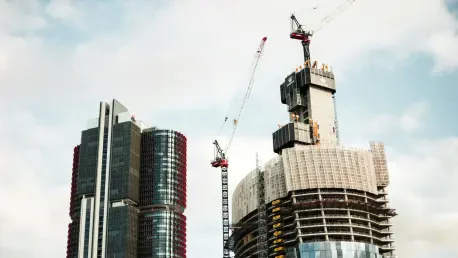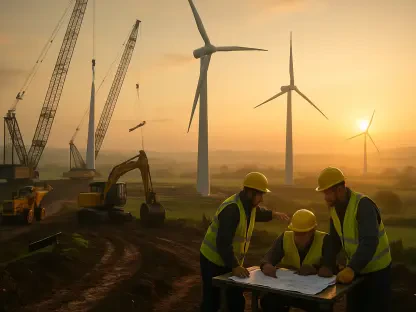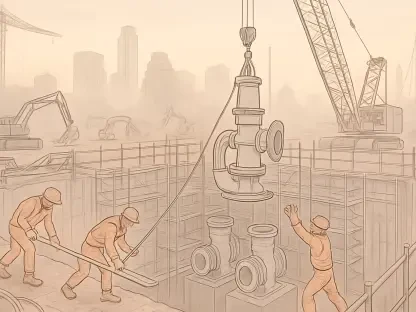Saudi Arabia’s construction equipment market is set for significant growth due to transformative initiatives under Vision 2030. The country’s ambitious framework, designed to diversify its economy and reduce its dependency on oil, is fueling a burgeoning demand for construction equipment. This transformation is largely attributed to various large-scale infrastructure projects, which are key to Vision 2030’s objective of building a sustainable, diversified economic base. According to Arizton Advisory and Intelligence, the market is projected to grow at a compound annual growth rate (CAGR) of 5.92%, with sales climbing from 37.27 thousand units to approximately 52.62 thousand units between 2025 and 2030. Such an expansion is emblematic of Saudi Arabia’s commitment to urban development, infrastructure advancement, and sustainable practices. These elements are pivotal in propelling the construction industry’s growth and reshaping the Kingdom’s economic landscape.
Vision 2030: Driving Economic and Infrastructure Development
A central pillar of Vision 2030 is its emphasis on sustainability and economic diversification, crucial for achieving net-zero carbon emissions by 2060. This initiative seeks to establish Saudi Arabia as a leader in the green hydrogen economy through significant investments in technologically advanced projects. The development of hydrogen-fueled plants, alongside an increased focus on green hydrogen production, is prompting a shift towards the integration of sustainable technologies in construction equipment. This evolution highlights a commitment to environmentally friendly practices, impacting the types of machinery employed across sectors. The integration of hydrogen-powered engines into heavy construction and industrial machinery demonstrates this commitment, reshaping the construction equipment landscape to align with global sustainability goals.
The grand vision further extends to ambitious urbanization and infrastructure advancements evident in the broad spectrum of projects currently underway. These endeavors are not only enhancing transportation networks but also paving the path for massive investment and job creation. Major infrastructural projects, such as the development of the futuristic NEOM city and extensive transit systems, are emblematic of Saudi Arabia’s strategic approach to urban development. This expansion is expected to invigorate the construction industry, elevating the demand for a wide range of construction equipment, thereby serving as a catalyst for economic growth and setting the stage for fostering global competitiveness.
Rising Demand in Waste Management and Recycling
Complementing the infrastructural drive under Vision 2030 is the Kingdom’s circular economy model, which focuses on recycling and waste-to-energy projects. This approach aligns with the strategic goals of reducing environmental impact and enhancing resource efficiency. The Saudi Investment Recycling Company (SIRC) is spearheading this transformative leap by rolling out extensive projects designed to revolutionize waste management. By converting waste into valuable resources through energy recovery initiatives, these efforts are not only reducing landfill dependency but are also increasing the need for specialized equipment. In particular, the demand for machinery like wheeled loaders is projected to rise substantially within the waste and recycling sector, serving as an essential component in the success of sustainable urban management strategies.
Furthermore, this demand is echoed by the increasing focus on developing advanced facilities capable of converting waste into energy. The imminent expansion of the waste management infrastructure leads to broader implications for the construction equipment market, particularly concerning equipment tailored for recycling and waste management applications. Supporting these endeavors are investments that are channeling resources towards the acquisition of advanced machinery, thereby fostering a modern approach to tackling environmental challenges. This newly established focus on sustainability is expected to further bolster growth prospects for the construction equipment market by incorporating innovative solutions and presenting new opportunities for stakeholders within the industry.
Expanding Residential Development and Housing Initiatives
Parallel to infrastructural advancements is the significant growth in residential development, spurred by the Saudi government’s initiatives to boost homeownership to 70% by 2030. Programs such as Wafi and Sakani play a crucial role in invigorating residential construction, subsequently leading to heightened demand for construction equipment. These initiatives are not only targeting higher homeownership rates but are also designed to foster public-private partnerships crucial for building affordable housing. Such efforts are driving construction activities nationwide, necessitating extensive use of varying construction machinery and amplifying market growth potential.
The momentum in residential construction is also augmented by a collaborative approach between government entities and private developers. These partnerships are rapidly advancing the development of extensive residential projects, contributing to an accelerated pace of modernization and infrastructure expansion. As residential areas continue to proliferate, the requirement for earthmoving and material handling equipment becomes pronounced, further bolstering the Saudi construction equipment market. Consequently, this surge is positioning the market for robust growth, presenting myriad opportunities for firms operating within this sector and emphasizing Saudi Arabia’s commitment to creating sustainable urban habitats.
Equipment Segmentation and Market Diversification
The dynamics within the Saudi construction equipment market reveal noteworthy trends, particularly concerning equipment segmentation and diversification. Earthmoving equipment remains a central component, with excavators leading this segment driven by ongoing public infrastructure initiatives. The expanding infrastructure, exemplified by projects like the Riyadh Metro, necessitates a substantial increase in demand for such equipment. The growth is equally mirrored within the material handling equipment sector, experiencing heightened demand due to logistical expansions and port developments. This trend is epitomized by the South Container Terminal enlargement at Jeddah Islamic Port, signifying an essential requirement for diverse machinery capable of handling increased cargo volumes.
The expanding road construction equipment segment also reflects an upward trajectory supported by significant transit and airport projects. The market experienced a CAGR of 5.46%, with developments like the King Abdulaziz International Airport playing a pivotal role. These expanding multimodal transportation networks necessitate the purchase and deployment of specialized equipment, driving growth within the sector. Moreover, the increasing penetration of advanced machinery underscores the importance of technology integration, fostering a competitive environment shaped by continuous innovation and diversification. These developments signal a prosperous horizon for the Saudi construction equipment market, driven not only by infrastructural needs but also by a steadfast commitment to technological progression.
Strengthening Market Competitiveness and FDI Influx
The Saudi construction equipment market is characterized by a robust and competitive landscape, dominated by global leaders such as Caterpillar, Komatsu, Volvo CE, and Hitachi. These industry titans benefit from an extensive product portfolio and strategic positioning that reinforce their dominance. However, the market is witnessing a new wave of competitiveness led by emerging players like JCB, Zoomlion, and HD Hyundai Construction Equipment. These companies are introducing cutting-edge machinery, aiming to challenge the established order by leveraging technological advancements. This increasingly competitive landscape fosters innovation and is crucial in driving the market’s evolution toward adopting advanced digital solutions in construction practices.
Another critical factor significantly influencing the market is the rise in foreign direct investment (FDI). Mega-projects such as NEOM and the Red Sea Project have attracted substantial international interest, leading to more than 3,800 construction licenses issued just in 2024. This FDI influx highlights the promising opportunities present within the market and signifies the Kingdom’s capacity to offer potential returns on investment. The facilitation of strategic alliances between domestic and international players has been instrumental in broadening market access and accelerating the construction equipment sector’s growth. By promoting a conducive environment for investment, Saudi Arabia is positioned to ensure long-term sustainability and market competitiveness.
Network Distribution and Future Prospects
Vision 2030 emphasizes sustainability and economic diversification, crucial for achieving net-zero carbon emissions by 2060. This initiative aims to position Saudi Arabia as a leader in the green hydrogen economy through substantial investments in advanced technological projects. The establishment of hydrogen-fueled plants and a heightened focus on green hydrogen production is driving a shift towards integrating sustainable technologies in construction equipment, illustrating a commitment to eco-friendly practices. The introduction of hydrogen-powered engines into heavy construction and industrial machinery underscores this commitment, reshaping the landscape of construction equipment to align with global sustainability goals.
Additionally, Vision 2030 extends to ambitious urbanization and infrastructure projects currently unfolding. These ventures not only improve transportation networks but also spur significant investment and job creation. Landmark projects like the futuristic NEOM city and extensive transit systems exemplify Saudi Arabia’s strategic urban development approach. This expansion is expected to energize the construction industry, increasing demand for various construction equipment and fostering economic growth while enhancing global competitiveness.









